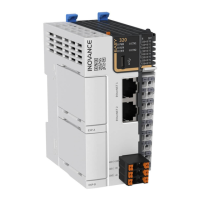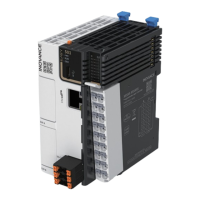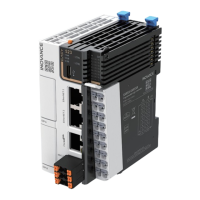Do you have a question about the Inovance Easy 301 and is the answer not in the manual?
Describes the Easy301 series PLC, its features, and the guide's scope.
Lists certifications, directives, and standards the product complies with.
Explains how to obtain the PDF user guide from the Inovance website.
Explains safety precautions, DANGER/WARNING/NOTICE messages, and Inovance's liability.
Defines DANGER, WARNING, and CAUTION levels for safety notices.
Advises on handling illustrations and protective guards for safe operation.
Warnings about damaged equipment or incorrect packing lists; cautions on integrity.
Cautions on handling, storing, and transporting the product safely to prevent damage.
Dangers related to installation by unqualified personnel and warnings on location and fire hazards.
Dangers of wiring by unqualified personnel, power-on wiring, and grounding; cautions on debris.
Warnings on voltage consistency and safety during power-on; dangers of operating at power-on.
Dangers of operation by unqualified personnel and warnings on touching hot components.
Dangers of maintenance by unqualified personnel and with power ON; warnings on routine inspection.
Dangers of repairing after power-on; warnings on fuse issues and operating damaged devices.
Warnings on proper disposal and recycling of retired equipment according to regulations.
Explains the safety label meaning regarding instructions, personal injuries, or equipment damage.
Details the Easy 301 model naming convention and nameplate information.
Identifies and labels the physical components of the PLC unit with numbers.
Describes the PWR, RUN, and ERR indicators and their states.
Details DIP switch, Type-C, RS485, and I/O terminal assignments.
Lists general technical specifications of the PLC, including program capacity and speed.
Details the electrical specifications for the PLC's power supply.
Lists the technical specifications for the PLC's digital inputs.
Lists the technical specifications for the PLC's digital outputs.
Specifies environmental requirements like temperature, humidity, and immunity for PLC installation.
Recommends horizontal installation with clearance for cooling and wiring.
Cautions for vertical installation regarding module placement and cable management.
Precaution to power off the master and modules before installing or removing them.
Shows physical dimensions and describes mounting the controller onto a DIN rail.
Step-by-step guide for mounting the PLC controller onto a DIN rail securely.
Describes attaching extension modules to the master unit via top and bottom rails.
Instructions on how to detach modules from the DIN rail using a tool.
Illustrates and lists the terminal assignments for PLC inputs and outputs.
Shows internal equivalent circuits for SINK and SOURCE input wiring.
Shows internal circuits and connections for output terminals.
Provides tables for selecting power and communication cables and lugs.
Lists the terminal assignments for RS485 and RS232 communication interfaces.
Details specifications for RS485 communication, including baud rate and isolation.
Details specifications for RS232 communication, including baud rate and isolation.
Guides on using shielded twisted pair cable, termination resistors, and grounding for RS485.
Steps to start and stop the PLC, including RUN indicator status.
Describes the Easy301 series PLC, its features, and the guide's scope.
Lists certifications, directives, and standards the product complies with.
Explains how to obtain the PDF user guide from the Inovance website.
Explains safety precautions, DANGER/WARNING/NOTICE messages, and Inovance's liability.
Defines DANGER, WARNING, and CAUTION levels for safety notices.
Advises on handling illustrations and protective guards for safe operation.
Warnings about damaged equipment or incorrect packing lists; cautions on integrity.
Cautions on handling, storing, and transporting the product safely to prevent damage.
Dangers related to installation by unqualified personnel and warnings on location and fire hazards.
Dangers of wiring by unqualified personnel, power-on wiring, and grounding; cautions on debris.
Warnings on voltage consistency and safety during power-on; dangers of operating at power-on.
Dangers of operation by unqualified personnel and warnings on touching hot components.
Dangers of maintenance by unqualified personnel and with power ON; warnings on routine inspection.
Dangers of repairing after power-on; warnings on fuse issues and operating damaged devices.
Warnings on proper disposal and recycling of retired equipment according to regulations.
Explains the safety label meaning regarding instructions, personal injuries, or equipment damage.
Details the Easy 301 model naming convention and nameplate information.
Identifies and labels the physical components of the PLC unit with numbers.
Describes the PWR, RUN, and ERR indicators and their states.
Details DIP switch, Type-C, RS485, and I/O terminal assignments.
Lists general technical specifications of the PLC, including program capacity and speed.
Details the electrical specifications for the PLC's power supply.
Lists the technical specifications for the PLC's digital inputs.
Lists the technical specifications for the PLC's digital outputs.
Specifies environmental requirements like temperature, humidity, and immunity for PLC installation.
Recommends horizontal installation with clearance for cooling and wiring.
Cautions for vertical installation regarding module placement and cable management.
Precaution to power off the master and modules before installing or removing them.
Shows physical dimensions and describes mounting the controller onto a DIN rail.
Step-by-step guide for mounting the PLC controller onto a DIN rail securely.
Describes attaching extension modules to the master unit via top and bottom rails.
Instructions on how to detach modules from the DIN rail using a tool.
Illustrates and lists the terminal assignments for PLC inputs and outputs.
Shows internal equivalent circuits for SINK and SOURCE input wiring.
Shows internal circuits and connections for output terminals.
Provides tables for selecting power and communication cables and lugs.
Lists the terminal assignments for RS485 and RS232 communication interfaces.
Details specifications for RS485 communication, including baud rate and isolation.
Details specifications for RS232 communication, including baud rate and isolation.
Guides on using shielded twisted pair cable, termination resistors, and grounding for RS485.
Steps to start and stop the PLC, including RUN indicator status.
| Brand | Inovance |
|---|---|
| Model | Easy 301 |
| Category | Controller |
| Language | English |











